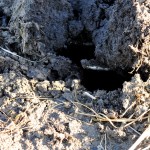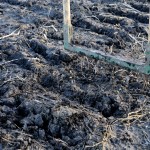- The broadfork being used on a previously worked bed that has been compressed by floodwater and left with a fine layer of silt on the surface.
- The long curved tines of the Broadfork
- Users view of the Broadfork in use.
- Pushing the handles down lifts the clumps of soil alowing the upper layers of soil to dry, break any ‘pan’ formed by rotavating and allowing air to penetrate the lower layers.
- Tine underneath the clump
- Raised clumps of soil created by the Broadfork
I spent most of last Thursday with the Broadfork. I had a conversation with a lifelong farmer on how to fix our soil after the flood. He advised me the first thing we should do is run a cultivator through the soil to break up the compacted upper layers and let some oxygen in.
This will help those top layers dry out and stimulate some of the microbes that are locked into this suffocated layer. If you think about it, water is very heavy and we have had tonnes of pressure bearing down on the soil for a prolonged period.
On some areas of the field we will bring a contractor in to do this work for us, but for the parts of the market garden worked over the last couple of years, the Broadfork is the answer.
Fourteen-inch-long spikes pierce the ground from a wide steel bar that you can stand on. Pulling the two ash handles back towards your body then lifts the soil allowing air into the layers beneath. Pushing the handles back into the vertical position then lowers the soil back into place.
Normally I wouldn’t recommend pushing the handles down until they are parallel with the ground when you are lifting the clumps of earth up with the tines, it’s too much effort. But because the ground was so compacted, this action seemed necessary.
If you space the points that you insert the tines into the ground correctly, when you lower the soil back down, it sits on the shoulder of the previous clod of lifted soil. This leaves a space about a foot down, that air and water can penetrate. The clods of soil now lifted up can drain into this space and any future rain can also drain through leaving the soil above to dry.
Leaving it to dry out like this for a couple of days means that running the rotavator through should yield a nice workable bed. The Broadfork is also a brilliant tool for breaking up the compacted soil ‘pan’ that develops from too much rotavator use. The rotavator reaches a maximum depth of 8 inches and continuous use of this implement causes a compacted layer to form in time just under this depth. The Broadfork breaks this up.
Using leverage of the long ash handles, broadforking isn’t as strenuous as you might think, but it’s great exercise causing you to continually bend and stretch. Ash is a wood with great strength yet the ability to bend a little and absorb the shock of levering the tines out of the ground. Ash is a brilliant wood for tool handles and is used to this day as part of the chassis of Morgan sports cars.
If must also be said that having a little more body weigh plays to your advantage when using the Broadfork. Getting the prongs down into the soil is simply achieved by stepping on the bar. If you’re a ‘lightweight’, standing on the bar may need a rocking motion to get the tines fully buried.
I would avoid the temptation to lift and throw the Broadfork into the ground. Firstly, this is pretty dangerous. You could easily put the things through your foot; don’t go there. Also, it is really wasteful energy wise and you will quickly wear yourself out if you don’t’ pull a muscle first.
The ability for soil to compact and become an impervious layer is quite astounding. When I was digging some more slip trenches recently after the flood, I was surprised to find that despite being under 5 feet of water, layers of the soil were bone dry just spades depth under the surface.
The Broadfork would be on my essentials list for any market gardener using a permanent bed system.






